《商业银行经营管理》课后练习题.
- 格式:doc
- 大小:31.00 KB
- 文档页数:14
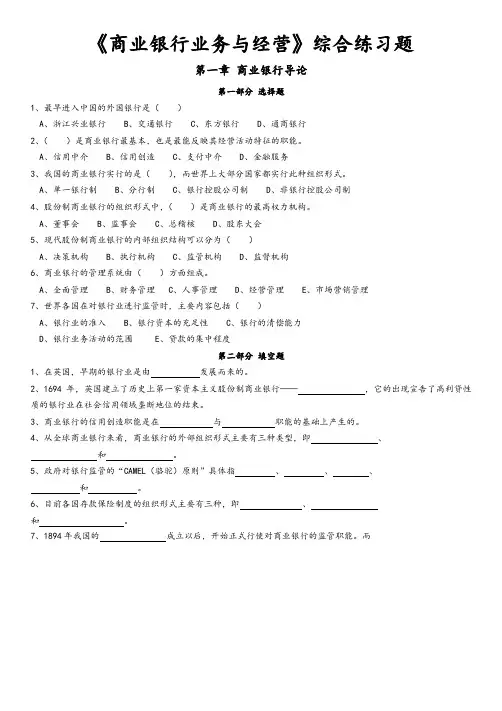
《商业银行业务与经营》综合练习题第一章商业银行导论第一部分选择题1、最早进入中国的外国银行是()A、浙江兴业银行B、交通银行C、东方银行D、通商银行2、()是商业银行最基本,也是最能反映其经营活动特征的职能。
A、信用中介B、信用创造C、支付中介D、金融服务3、我国的商业银行实行的是(),而世界上大部分国家都实行此种组织形式。
A、单一银行制B、分行制C、银行控股公司制D、非银行控股公司制4、股份制商业银行的组织形式中,()是商业银行的最高权力机构。
A、董事会B、监事会C、总稽核D、股东大会5、现代股份制商业银行的内部组织结构可以分为()A、决策机构B、执行机构C、监管机构D、监督机构6、商业银行的管理系统由()方面组成。
A、全面管理B、财务管理C、人事管理D、经营管理E、市场营销管理7、世界各国在对银行业进行监管时,主要内容包括()A、银行业的准入B、银行资本的充足性C、银行的清偿能力D、银行业务活动的范围E、贷款的集中程度第二部分填空题1、在英国,早期的银行业是由发展而来的。
2、1694年,英国建立了历史上第一家资本主义股份制商业银行——,它的出现宣告了高利贷性质的银行业在社会信用领域垄断地位的结束。
3、商业银行的信用创造职能是在与职能的基础上产生的。
4、从全球商业银行来看,商业银行的外部组织形式主要有三种类型,即、和。
5、政府对银行监管的“CAMEL(骆驼)原则”具体指、、、和。
6、目前各国存款保险制度的组织形式主要有三种,即、和。
7、1894年我国的成立以后,开始正式行使对商业银行的监管职能。
而2003年12月27日,《中华人民共和国银行业监督管理法》,明确是银行业的监督管理机构。
第三部分名词解释1、信用创造2、银行控股公司制3、商业银行的外部组织形式4、商业银行的内部组织形式5、存款保险制度第四部分问答题1、商业银行在一国经济发展过程中发挥了什么样的作用?2、商业银行单一银行制有哪些优缺点?商业银行分行制有哪些优缺点?3、政府为什么要对银行业实施监管?我国政府如何对银行业实施监管?第二章商业银行的资本管理第一部分选择题1、一家银行在发展过程中,会遇到各种各样的风险,例如()A、信用风险B、利率风险C、汇率风险D、经营风险E、流动性风险2、(),国际清算银行通过了《关于统一国际银行资本衡量和资本标准的协议》(即《巴塞尔协议》),规定12个参加国应以国际可比性及一致性为基础制定各自银行资本标准。

商业银行经营学第二章一、单项选择题(每个题目只有一个正确答案,请选择正确答案)1. 发行优先股对商业银行的不足之处不包括()。
A.股息税后支付,增加了资金成本B.总资本收益率下降时,会发生杠杆作用,影响普通股股东的权益C.不会稀释控制权D.可以在市场行情变动时对优先股进行有利于自己的转化,增大了经营的不确定性2. 一旦银行破产、倒闭时,对银行的资产的要求权排在最后的是()。
A.优先股股东B.普通股股东C.债权人D.存款人3. 发行普通股对商业银行的不足之处不包括()。
A.发行成本比较高B.对商业银行的股东权益产生稀释作用C.资金成本总要高于优先股和债券D.总资本收益率下降时,会发生杠杆作用4. 资本盈余是指发行普通股时发行的实际价格高于()的部分A.发行的预计价格B.票面价值C.实际价值D.每股净资产5. 下列各项不属于发行资本债券特点的有()。
A.不稀释控制权B.能大量发行,满足融资需求C.利息税前支付,可降低税后成本D.利息固定,会发生杠杆作用6. 资本与总资产比率和资本与存款比率相比,克服了()的不足。
A.没考虑资金运用B.没反映银行资产结构C.没考虑风险D.没考虑商业银行经营管理水平7. 下列关于纽约共识的说法中正确的有()。
A.它根据商业银行资本风险程度的不同,将全部资本分做六类B.其中的无风险资产包括:库存现金、同业拆借、国债、优质商业票据等C.亏损了的资产或固定资产也叫有问题资产,需要100%的资本保证D.商业银行只要将各类资产额分别乘以各自的资本资产比率要求,并进行加总,便可以求得商业银行所需的最低资本量8. 下列各项不属于综合分析法特点的有()。
A.非数量性B.不确定性C.繁琐D.客观性9. 下列各项不属于非公开储备特点的有()。
A.是指不在银行的资产负债表上公开标明的储备B.包括在核心资本中C.与公开储备具有相同的质量D.可以自由、及时地被用于应付未来不可预见的损失10. 下列关于资本需要量的说法中正确的是()。
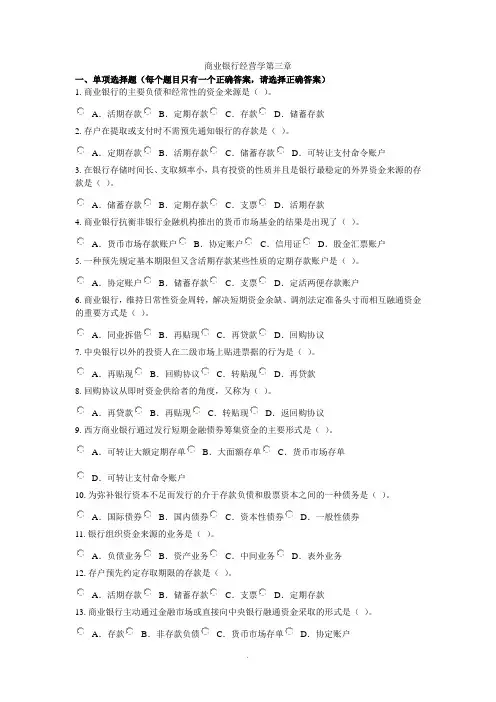
商业银行经营学第三章一、单项选择题(每个题目只有一个正确答案,请选择正确答案)1. 商业银行的主要负债和经常性的资金来源是()。
A.活期存款B.定期存款C.存款D.储蓄存款2. 存户在提取或支付时不需预先通知银行的存款是()。
A.定期存款B.活期存款C.储蓄存款D.可转让支付命令账户3. 在银行存储时间长、支取频率小,具有投资的性质并且是银行最稳定的外界资金来源的存款是()。
A.储蓄存款B.定期存款C.支票D.活期存款4. 商业银行抗衡非银行金融机构推出的货币市场基金的结果是出现了()。
A.货币市场存款账户B.协定账户C.信用证D.股金汇票账户5. 一种预先规定基本期限但又含活期存款某些性质的定期存款账户是()。
A.协定账户B.储蓄存款C.支票D.定活两便存款账户6. 商业银行,维持日常性资金周转,解决短期资金余缺、调剂法定准备头寸而相互融通资金的重要方式是()。
A.同业拆借B.再贴现C.再贷款D.回购协议7. 中央银行以外的投资人在二级市场上贴进票据的行为是()。
A.再贴现B.回购协议C.转贴现D.再贷款8. 回购协议从即时资金供给者的角度,又称为()。
A.再贷款B.再贴现C.转贴现D.返回购协议9. 西方商业银行通过发行短期金融债券筹集资金的主要形式是()。
A.可转让大额定期存单B.大面额存单C.货币市场存单D.可转让支付命令账户10. 为弥补银行资本不足而发行的介于存款负债和股票资本之间的一种债务是()。
A.国际债券B.国内债券C.资本性债券D.一般性债券11. 银行组织资金来源的业务是()。
A.负债业务B.资产业务C.中间业务D.表外业务12. 存户预先约定存取期限的存款是()。
A.活期存款B.储蓄存款C.支票D.定期存款13. 商业银行主动通过金融市场或直接向中央银行融通资金采取的形式是()。
A.存款B.非存款负债C.货币市场存单D.协定账户14. 下列不属于一般性金融债券的是()。
A.信用债券B.普通金融债券C.资本性债券D.担保债券15. 影响存款水平的微观因素主要是银行内的因素,不包括()。
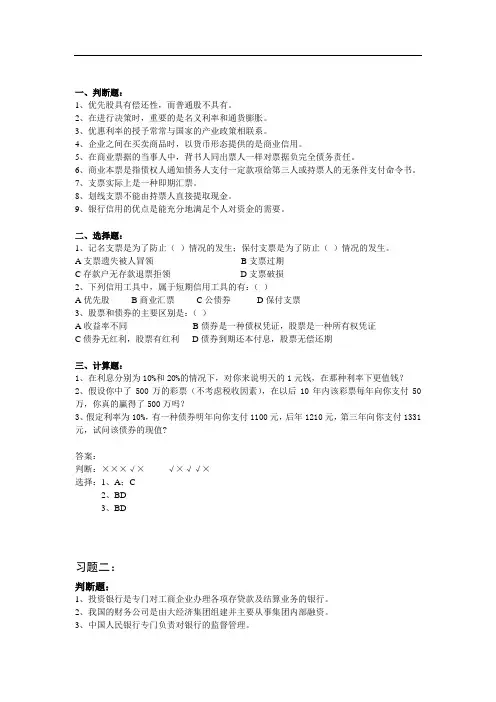
一、判断题:1、优先股具有偿还性,而普通股不具有。
2、在进行决策时,重要的是名义利率和通货膨胀。
3、优惠利率的授予常常与国家的产业政策相联系。
4、企业之间在买卖商品时,以货币形态提供的是商业信用。
5、在商业票据的当事人中,背书人同出票人一样对票据负完全债务责任。
6、商业本票是指债权人通知债务人支付一定款项给第三人或持票人的无条件支付命令书。
7、支票实际上是一种即期汇票。
8、划线支票不能由持票人直接提取现金。
9、银行信用的优点是能充分地满足个人对资金的需要。
二、选择题:1、记名支票是为了防止()情况的发生;保付支票是为了防止()情况的发生。
A支票遗失被人冒领B支票过期C存款户无存款退票拒领D支票破损2、下列信用工具中,属于短期信用工具的有:()A优先股B商业汇票C公债券D保付支票3、股票和债券的主要区别是:()A收益率不同B债券是一种债权凭证,股票是一种所有权凭证C债券无红利,股票有红利D债券到期还本付息,股票无偿还期三、计算题:1、在利息分别为10%和20%的情况下,对你来说明天的1元钱,在那种利率下更值钱?2、假设你中了500万的彩票(不考虑税收因素),在以后10年内该彩票每年向你支付50万,你真的赢得了500万吗?3、假定利率为10%,有一种债券明年向你支付1100元,后年1210元,第三年向你支付1331元,试问该债券的现值?答案:判断:×××√×√×√√×选择:1、A;C2、BD3、BD习题二:判断题:1、投资银行是专门对工商企业办理各项存贷款及结算业务的银行。
2、我国的财务公司是由大经济集团组建并主要从事集团内部融资。
3、中国人民银行专门负责对银行的监督管理。
4、外资金融机构在华代表处可以开展直接营利的业务。
选择题:1、直接融资领域中的金融中介机构有:A商业银行B投资银行C证券公司D证券交易所2、间接融资领域中的金融中介机构有:A存款货币银行B投资银行C证券公司D证券经纪人3、以经营工商业存、贷款为主要业务,并为顾客提供多种服务的银行是:A中央银行B商业银行C投资银行D储蓄银行4、一般是由政府设立,以贯彻国家产业政策、区域发展政策等为目标,盈利目标居次要地位的金融机构是:A中央银行B商业银行C投资银行D政策性银行5、投资银行资金来源的筹集主要依靠:A发行股票B发行债券C吸收活期存款D吸收定期存款6、中国人民银行,作为国务院组成部门,其主要职责是:A制定和执行货币政策B吸收居民储蓄存款C维护金融稳定D对企业发放贷款7、我国政策性银行的资金来源的主要渠道是:A财政拨付B由原来的各专业银行划出的资本金C发行票据D发行金融债券8、处于我国金融中介体系中主体地位的国有商业银行有:A中国工商银行B中国民生银行C中国农业银行D中国光大银行9、我国组建金融资产管理公司的目的在于:A改善四家国有独资商业银行的资产负债状况B实现不良贷款价值回收最大化C对符合条件的企业实施债权转股权D为居民提供最优金融服务10、我国的综合类证券公司可以从事:A资金的转账结算业务B证券承销业务C自营业务D证券经纪类业务简答题:1、银行解决信息不对称的方法有哪些?×√××1、BCD2、A3、B4、D5、ABD6、AC7、ABD8、AC 9、ABC 10、BCD习题三:一、判断题:1、商业银行的资金主要由自有资本构成。

商业银行练习题及答案导言:商业银行在金融体系中扮演着重要的角色,为经济的发展提供资金支持和金融服务。
为了加深对商业银行的理解,以下是一些常见的商业银行练习题及答案,帮助读者巩固对该领域的知识。
第一部分:选择题1. 以下哪项不是商业银行的基本职能?a) 存款业务b) 贷款业务c) 外汇兑换业务d) 股票交易业务答案:d) 股票交易业务。
商业银行的基本职能包括接受存款、发放贷款、进行外汇兑换等,股票交易业务属于证券公司的职能领域。
2. 在商业银行中,负责发放个人贷款的部门是:a) 零售金融部b) 企业金融部c) 风险管理部d) 资产管理部答案:a) 零售金融部。
商业银行通常分为零售金融部和企业金融部两大部门,零售金融部负责发放个人贷款,企业金融部负责对企业进行融资支持。
3. 商业银行的主要利润来源是:a) 利息差b) 手续费收入c) 投资收益d) 资本利得答案:a) 利息差。
商业银行通过存款贷款的利息差来获取利润,手续费收入、投资收益和资本利得也是银行的收入来源,但利息差是主要利润来源。
第二部分:填空题1. 商业银行属于______,是金融体系中的重要组成部分。
答案:金融机构。
2. 商业银行在资金划转中起到了________的作用。
答案:中介。
第三部分:解答题1. 商业银行与其他金融机构的区别是什么?请列举至少两点。
答案:首先,商业银行的主要业务是接受储户存款和发放贷款,而非金融机构可能会从事证券经纪、保险等其他业务。
其次,商业银行可以发行货币,具有货币创造的功能,而其他金融机构没有这个权力。
2. 商业银行的风险管理包括哪些方面?请简要说明。
答案:商业银行的风险管理主要包括信用风险、流动性风险和市场风险。
信用风险是指借款人无法按时偿还贷款的风险,流动性风险是指银行面临资金不足导致无法及时偿还债务的风险,市场风险是指银行持有的投资资产在市场价格波动中造成的损失的风险。
总结:商业银行是金融体系中不可或缺的重要组成部分,其在经济发展中发挥着重要的支持和服务作用。
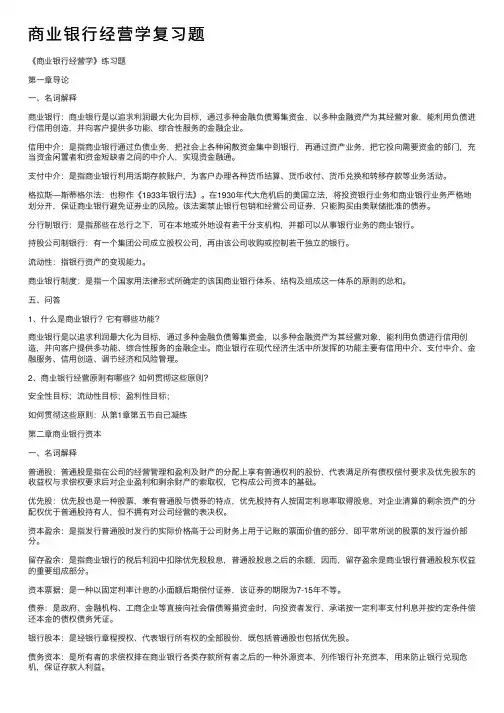
商业银⾏经营学复习题《商业银⾏经营学》练习题第⼀章导论⼀、名词解释商业银⾏:商业银⾏是以追求利润最⼤化为⽬标,通过多种⾦融负债筹集资⾦,以多种⾦融资产为其经营对象,能利⽤负债进⾏信⽤创造,并向客户提供多功能、综合性服务的⾦融企业。
信⽤中介:是指商业银⾏通过负债业务,把社会上各种闲散资⾦集中到银⾏,再通过资产业务,把它投向需要资⾦的部门,充当资⾦闲置者和资⾦短缺者之间的中介⼈,实现资⾦融通。
⽀付中介:是指商业银⾏利⽤活期存款账户,为客户办理各种货币结算、货币收付、货币兑换和转移存款等业务活动。
格拉斯—斯蒂格尔法:也称作《1933年银⾏法》。
在1930年代⼤危机后的美国⽴法,将投资银⾏业务和商业银⾏业务严格地划分开,保证商业银⾏避免证券业的风险。
该法案禁⽌银⾏包销和经营公司证券,只能购买由美联储批准的债券。
分⾏制银⾏:是指那些在总⾏之下,可在本地或外地设有若⼲分⽀机构,并都可以从事银⾏业务的商业银⾏。
持股公司制银⾏:有⼀个集团公司成⽴股权公司,再由该公司收购或控制若⼲独⽴的银⾏。
流动性:指银⾏资产的变现能⼒。
商业银⾏制度:是指⼀个国家⽤法律形式所确定的该国商业银⾏体系、结构及组成这⼀体系的原则的总和。
五、问答1、什么是商业银⾏?它有哪些功能?商业银⾏是以追求利润最⼤化为⽬标,通过多种⾦融负债筹集资⾦,以多种⾦融资产为其经营对象,能利⽤负债进⾏信⽤创造,并向客户提供多功能、综合性服务的⾦融企业。
商业银⾏在现代经济⽣活中所发挥的功能主要有信⽤中介、⽀付中介、⾦融服务、信⽤创造、调节经济和风险管理。
2、商业银⾏经营原则有哪些?如何贯彻这些原则?安全性⽬标;流动性⽬标;盈利性⽬标;如何贯彻这些原则:从第1章第五节⾃⼰凝练第⼆章商业银⾏资本⼀、名词解释普通股:普通股是指在公司的经营管理和盈利及财产的分配上享有普通权利的股份,代表满⾜所有债权偿付要求及优先股东的收益权与求偿权要求后对企业盈利和剩余财产的索取权,它构成公司资本的基础。
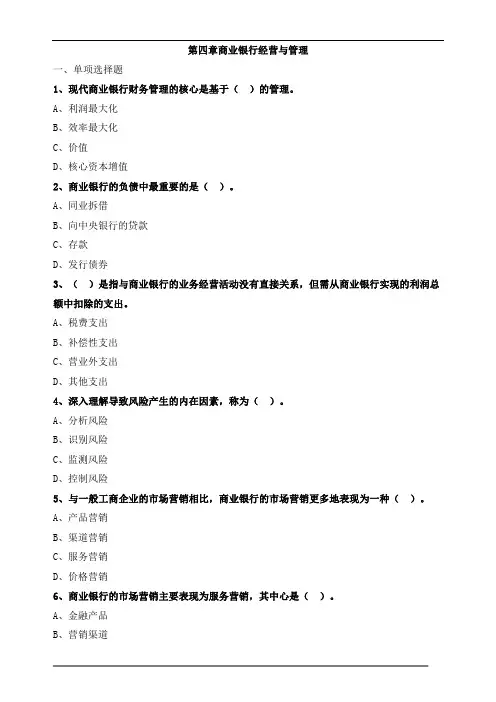
第四章商业银行经营与管理一、单项选择题1、现代商业银行财务管理的核心是基于()的管理。
A、利润最大化B、效率最大化C、价值D、核心资本增值2、商业银行的负债中最重要的是()。
A、同业拆借B、向中央银行的贷款C、存款D、发行债券3、()是指与商业银行的业务经营活动没有直接关系,但需从商业银行实现的利润总额中扣除的支出。
A、税费支出B、补偿性支出C、营业外支出D、其他支出4、深入理解导致风险产生的内在因素,称为()。
A、分析风险B、识别风险C、监测风险D、控制风险5、与一般工商企业的市场营销相比,商业银行的市场营销更多地表现为一种()。
A、产品营销B、渠道营销C、服务营销D、价格营销6、商业银行的市场营销主要表现为服务营销,其中心是()。
A、金融产品B、营销渠道D、银行盈利7、商业银行致力于与客户建立更加稳定的关系,属于商业银行市场营销中的()。
A、关系营销B、用户管理C、传统营销D、产品营销8、商业银行的经营是其对所开展的各种业务活动的()。
A、控制与监督B、调整和监督C、组织和控制D、组织和营销9、商业银行资产的流动性是指商业银行资产能够迅速变现的能力,其迅速变现的条件是资产()。
A、略有增值B、不受损失C、有损失D、较大增值10、固定收益类理财产品投资于存款、债券等债权类资产的比例不低于()。
A、50%B、60%C、80%D、100%11、理财产品份额总额不固定的是。
()A、非估值型理财产品B、估值型理财产品C、封闭式理财产品D、开放式理财产品12、商业银行发行公募理财产品的,单一投资者销售起点金额不得低于()人民币。
A、5000元B、1万元D、3万元13、在商业银行资产负债管理中,规模对称原理的动态平衡的基础是()。
A、合理经济体制B、合理经济结构C、合理经济规模D、合理经济增长14、根据速度对称原理,如果平均流动率大于1,则说明()。
A、资产运用过度B、资产运用不足C、负债来源过度D、负债来源不足15、商业银行平衡银行流动性和效益性的重要工具是()。
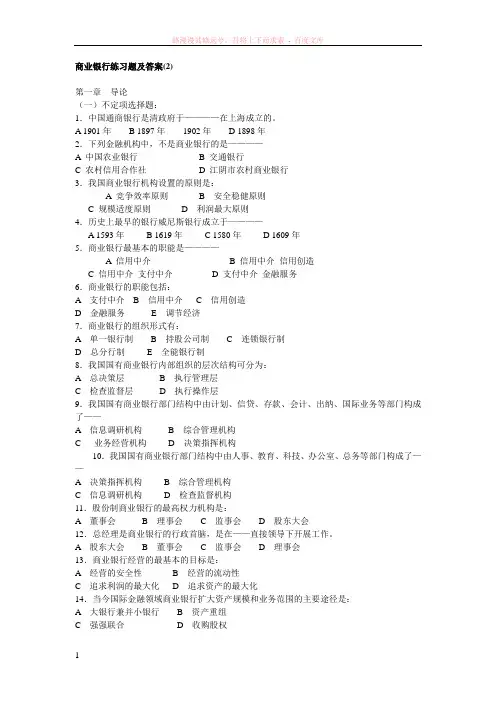
商业银行练习题及答案(2)第一章导论(一)不定项选择题:1.中国通商银行是清政府于————在上海成立的。
A 1901年B 1897年1902年 D 1898年2.下列金融机构中,不是商业银行的是————A 中国农业银行B 交通银行C 农村信用合作社D 江阴市农村商业银行3.我国商业银行机构设置的原则是:A 竞争效率原则B 安全稳健原则C 规模适度原则D 利润最大原则4.历史上最早的银行威尼斯银行成立于————A 1593年B 1619年C 1580年D 1609年5.商业银行最基本的职能是————A 信用中介B 信用中介信用创造C 信用中介支付中介D 支付中介金融服务6.商业银行的职能包括:A 支付中介B 信用中介C 信用创造D 金融服务E 调节经济7.商业银行的组织形式有:A 单一银行制B 持股公司制C 连锁银行制D 总分行制E 全能银行制8.我国国有商业银行内部组织的层次结构可分为:A 总决策层B 执行管理层C 检查监督层D 执行操作层9.我国国有商业银行部门结构中由计划、信贷、存款、会计、出纳、国际业务等部门构成了——A 信息调研机构B 综合管理机构C 业务经营机构D 决策指挥机构10.我国国有商业银行部门结构中由人事、教育、科技、办公室、总务等部门构成了——A 决策指挥机构B 综合管理机构C 信息调研机构D 检查监督机构11.股份制商业银行的最高权力机构是:A 董事会B 理事会C 监事会D 股东大会12.总经理是商业银行的行政首脑,是在——直接领导下开展工作。
A 股东大会B 董事会C 监事会D 理事会13.商业银行经营的最基本的目标是:A 经营的安全性B 经营的流动性C 追求利润的最大化D 追求资产的最大化14.当今国际金融领域商业银行扩大资产规模和业务范围的主要途径是:A 大银行兼并小银行B 资产重组C 强强联合D 收购股权15.历史上最早的银行是:A 威尼斯银行B 米兰银行C 阿姆斯特丹银行D 汉堡银行16.1999年11月美国国会通过了意在取消金融业分业经营的法案是:A 《格拉斯-斯蒂格尔法》B 《美国联邦储备银行法》C 《美国商业银行法》D 《金融服务现代化法案》17.世界上第一家网络银行是:A 美国花旗银行B 美国信浮银行C 日本第一劝业银行D 美国安全第一网络银行18.商业银行信用中介的职能主要充当的是:A 买卖资本商品的所有权B 买卖资本商品的使用权C 充当资金交换的媒介D 办理货币的收付和兑换19.商业银行信用创造的限制条件有:A 存款额B 准备金率C 贷款的有效需求D 存款付现率20.商业银行经营的流动性方针是指:A 保持资产的流动性B 保持负债的流动性C 所持资产的变现能力D 是获得资金的负债能力(二)复习思考题:1.名词解释:商业银行信用创造支付中介流动性效益性基础货币全能化经营信用中介单一银行制2.简述现代商业银行的发展趋势。
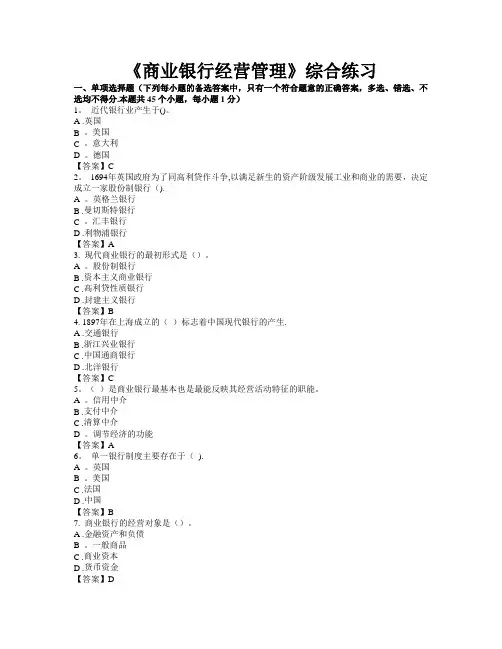
《商业银行经营管理》综合练习一、单项选择题(下列每小题的备选答案中,只有一个符合题意的正确答案,多选、错选、不选均不得分.本题共45个小题,每小题1分)1。
近代银行业产生于()。
A .英国B 。
美国C 。
意大利D 。
德国【答案】C2。
1694年英国政府为了同高利贷作斗争,以满足新生的资产阶级发展工业和商业的需要,决定成立一家股份制银行().A 。
英格兰银行B .曼切斯特银行C 。
汇丰银行D .利物浦银行【答案】A3. 现代商业银行的最初形式是()。
A 。
股份制银行B .资本主义商业银行C .高利贷性质银行D .封建主义银行【答案】B4. 1897年在上海成立的()标志着中国现代银行的产生.A .交通银行B .浙江兴业银行C .中国通商银行D .北洋银行【答案】C5。
()是商业银行最基本也是最能反映其经营活动特征的职能。
A 。
信用中介B .支付中介C .清算中介D 。
调节经济的功能【答案】A6。
单一银行制度主要存在于().A 。
英国B 。
美国C .法国D .中国【答案】B7. 商业银行的经营对象是()。
A .金融资产和负债B 。
一般商品C .商业资本D .货币资金【答案】D8. 对于发行普通股,下面的表述错误的是()。
A .发行成本比较高B 。
对商业银行的股东权益产生稀释作用C 。
资金成本总要高于优先股和债券D 。
总资本收益率下降时,会产生杠杆作用【答案】D9. 附属资本不包括()。
A .未公开储备B .股本C .重估储备D 。
普通准备金【答案】B10. 总资本与风险加权资本的比率不得低于()。
A 。
7%B 。
8%C 。
9%D .10%【答案】B11。
年初的资本/资产=8%,各种资产为10亿元,年末的比例仍为8%,年末的未分配收益为0。
2亿元,银行的适度资本为().A 。
12。
5B 。
10C .10。
2D 。
12.7【答案】A12。
商业银行最主要的负债是().A 。
借款B .发行债券C .各项存款D 。
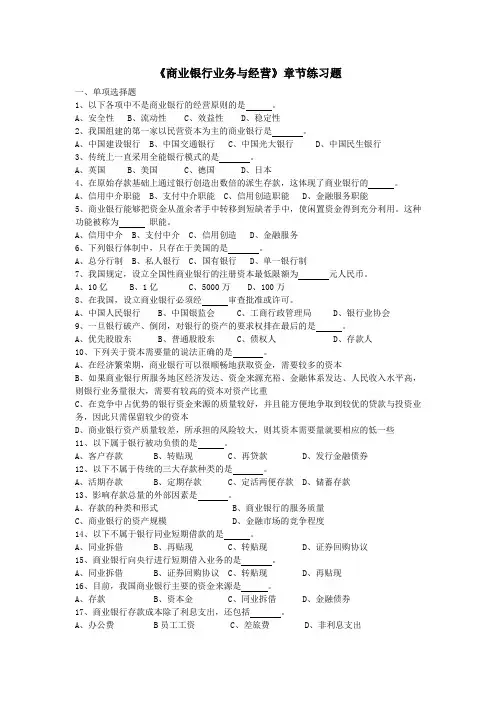
《商业银行业务与经营》章节练习题一、单项选择题1、以下各项中不是商业银行的经营原则的是。
A、安全性B、流动性C、效益性D、稳定性2、我国组建的第一家以民营资本为主的商业银行是。
A、中国建设银行B、中国交通银行C、中国光大银行D、中国民生银行3、传统上一直采用全能银行模式的是。
A、英国B、美国C、德国D、日本4、在原始存款基础上通过银行创造出数倍的派生存款,这体现了商业银行的。
A、信用中介职能B、支付中介职能C、信用创造职能D、金融服务职能5、商业银行能够把资金从盈余者手中转移到短缺者手中,使闲置资金得到充分利用。
这种功能被称为职能。
A、信用中介B、支付中介C、信用创造D、金融服务6、下列银行体制中,只存在于美国的是。
A、总分行制B、私人银行C、国有银行D、单一银行制7、我国规定,设立全国性商业银行的注册资本最低限额为元人民币。
A、10亿B、1亿C、5000万D、100万8、在我国,设立商业银行必须经审查批准或许可。
A、中国人民银行B、中国银监会C、工商行政管理局D、银行业协会9、一旦银行破产、倒闭,对银行的资产的要求权排在最后的是。
A、优先股股东B、普通股股东C、债权人D、存款人10、下列关于资本需要量的说法正确的是。
A、在经济繁荣期,商业银行可以很顺畅地获取资金,需要较多的资本B、如果商业银行所服务地区经济发达、资金来源充裕、金融体系发达、人民收入水平高,则银行业务量很大,需要有较高的资本对资产比重C、在竞争中占优势的银行资金来源的质量较好,并且能方便地争取到较优的贷款与投资业务,因此只需保留较少的资本D、商业银行资产质量较差,所承担的风险较大,则其资本需要量就要相应的低一些11、以下属于银行被动负债的是。
A、客户存款B、转贴现C、再贷款D、发行金融债券12、以下不属于传统的三大存款种类的是。
A、活期存款B、定期存款C、定活两便存款D、储蓄存款13、影响存款总量的外部因素是。
A、存款的种类和形式B、商业银行的服务质量C、商业银行的资产规模D、金融市场的竞争程度14、以下不属于银行同业短期借款的是。
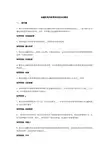
金融机构风险管理机制知识测试一、填空题1. 银行业监督管理机构应当对银行业金融机构的业务活动及其风险状况进行___,建立银行业金融机构监督管理信息系统,分析、评价银行业金融机构的风险状况。
标准答案: 非现场监管2. 国务院银行业监督管理机构根据___的需要设立派出机构。
标准答案: 履行职责3. 银行业金融机构的___规则,由法律、行政法规规定,也可由国务院银行业监督管理机构依照法律、行政法规制定。
标准答案: 审慎经营4. 银行业金融机构业务范围内的业务品种,应当按照规定经国务院银行业监督管理机构审查批准或者___标准答案: 备案5. 国务院银行业监督管理机构对银行业金融机构的董事和高级管理人员实行___管理。
标准答案: 任职资格6. 国务院银行业监督管理机构对银行业金融机构的设立,应当自收到申请文件之日起___个月内,作出批准或者不批准的书面决定。
标准答案: 67. 银行业监督管理机构工作人员,应当依法保守___,并有责任为其监督管理的银行业金融机构及当事人保守秘密。
标准答案: 国家秘密8. 《银行业监督管理法》的立法目的是为了加强对银行业的监督管理,规范监督管理行为,防范和化解银行业风险,保护___和其他客户的合法权益,促进银行业健康发展。
标准答案: 存款人9. 银行业金融机构业务范围内需要审查批准或者备案的业务品种,由国务院银行业监督管理机构依照法律、行政法规作出规定并___标准答案: 公布10. 国务院银行业监督管理机构的派出机构在国务院银行业监督管理机构的___范围内,履行监督管理职责。
标准答案: 授权11. 国务院银行业监督管理机构对派出机构实行统一___。
标准答案: 领导和管理12. 国务院银行业监督管理机构对银行业自律组织的活动进行___标准答案: 指导和监督13. 国务院银行业监督管理机构对银行业金融机构的变更、终止,以及业务范围和增加业务范围内的业务品种, 应当自收到申请文件之日起___个月内,作出批准或者不批准的书面决定。
《商业银行经营管理》课后练习题第一章变化中的金融服务部门概览1、什么是银行?银行与其它金融机构有什么不同之处?2、根据美国法律,一家金融企业怎样才能成为合格的商业银行?3、为什么商业银行要拓展经营范围以成为提供一站式金融服务的联合体?你认为这种做法可取吗?4、哪些公司与银行最接近,是银行最强有力的竞争者?它们提供哪些服务于银行进行激烈的竞争?5、银行金融市场份额正在发生哪些变化?为什么?6、商业银行主要向公众提供哪些金融服务?列举一个与商业银行业务相近的非银行金融机构,比较之间差别?7、什么是金融百货公司?什么是全能银行?为什么这些机构在现代金融系统中变得如此重要?8、银行是金融中介,为什么银行作为金融中介会存在于现代社会?(**第一章探索性问题论坛:银行是什么?话题1:什么是银行?话题2:如何区别银行和其他金融机构?话题3:在银行什么岗位需要的人是最多的?第二章政府政策及监管对银行的影响1、银行有哪些重要领域和职能受到监管?*2、为什么要对银行的这些领域和职能进行监管?*3、(美国货币监理署的主要作用是什么?4、FDIC的主要工作是什么?5、联邦储备系统在银行和金融系统中的关键作用是什么?*6、什么是《格拉斯---斯蒂格尔法案》?该法案在银行业历史上为何重要?*9、FDIC是如何处理银行破产的?12、《金融服务现代法案》为银行业带来哪些变化?为什么会有这些变化?14、我们在使用金融服务用户的信息时为什么必须关注隐私问题?15、*(为什么《爱国者法案》和《萨班斯---奥克斯利法案》在美国得以通过?这些新法律及相关监管将会对金融机构产生哪些影响?22*。
(略(**第二章探索性问题论坛:为什么对银行的监管如此严格?话题1:在美国,监管银行的法律法规有哪些?主要监管哪些方面?话题2:在中国,监管银行的法律法规有哪些?主要监管哪些方面?话题3:对银行严格监管真的有必要吗?有观点认为,监管只会阻碍银行的发展… 你同意否?第三章银行的组织与结构1、画出一家小银行、一家大银行的组织结构图。
1、Fill in the Blank Questions(1)_______________________ is a newer service provided by bankswhere the bank lends money to individuals for the purchase of durable and other goods.(2)The loosening of government regulation and control of financialinstitutions is called ______ .(3)A bank which now offers all of the available financial services isknown as a __________bank.(4)A(n) buys and sells securities on behalf of their customersand for their own accounts. Examples of this type of financialservice provider include Merrill Lynch and Charles Schwab.(5)One tool that the Federal Reserve uses to control the money supply is___________. The Federal Reserve will buy and sell T-bills when they are using this tool of monetary policy.(6)The federal bank regulatory agency which examines the most banks isthe ______________.(7)The short term securities of the bank, including T-Bills andcommercial paper, are often called __________________________ because they are the second line of defense to meet demands for cash.(8)A(n)__________________________ is a deposit account which paysan interest rate competitive with money market mutual funds andwhich generally has limited check writing ability.(9)__________________________ can be held byindividuals and nonprofit institutions, bear interest and permit drafts from being written against the account to pay third parties.(10)The equity multiplier for a bank measures the amount of_____________________ of the bank and is one part of theevaluation of the bank's ROE.(11)__________________________ is the risk that the financialinstitution may not be able to meet the needs of depositors for cash. (12) A traditional measure of earnings efficiency is the__________________ or total interest income over total earnings assets less total interest expenses over total interest bearing bankliabilities. It measures the effectiveness of a firm’s intermediation function in the borrowing and lending of money.(13)The__________________ is the interest rate that equalizes thecurrent market price of a bond with the present value of the futurecash flows.(14)_________________________ is the difference betweeninterest-sensitive assets and interest-sensitive liabilities. Answer:Dollar interest-sensitive gap(15)A(n)_________________________ allows the holder the rightto either sell securities to another investor (put) or buy securities fromanother investor (call) for a set price before the expiration date. (16)A(n)_________________________ is a contract where twoparties exchange interest payments in order to save money and hedge against interest rate risk.(17)A(n)_________________________ is where there is both aminimum and a maximum interest rate set on a loan.(18)A(n) _________________________ is a contingent claim of thebank that issues it. The issuing bank, in return for a fee, guarantees the repayment of a loan received by its customer or the fulfillment ofa contract made by its customer to a third party.(19) A relatively new type of credit derivative is a CDO which standsfor __________________.(20)24. Lenders can set aside a group of loans on their balance sheet,issue bonds and pledge the loans as collateral against the bonds in____________ . These usually stay on the bank’s balance sheet as liabilities.(21)Debt instruments issued by cities, states and other political entitiesand which are exempt from federal taxes are collectively known as _____________________ .(22)__________________ is the risk that the company whosebonds the financial institution owns may retire the entire issue ofcorporate bonds in advance of their maturity leaving the bank with therisk of earnings losses resulting from reinvesting the cash at lowerinterest rates.(23)The _________________________ is the total difference betweenits sources and uses of funds. Answer: liquidity gap(24)The oldest approach to meeting liquidity needs which relies on thesale of liquid assets to meet liquidity demands is called_________________________.(25)_________________________ are the stable base of depositedfunds that are not highly sensitive to movements in market interest rates and tend to remain with a depository institution.(26)When financial institutions tempt customers by paying postageboth ways in bank-by-mail services or by offering free gifts such as teddy bears, they are practicing ___________.(27)When a customer is charged based on the number and kinds ofservices used, with the customers that use a number of services being charged less or having some fees waived, this is called__________________ pricing.(28)__________________ is the amount in excess of par value paidby the bank's shareholders.(29)Core capital such as common stock, surplus, undivided profits,qualifying noncumulative preferred stock, etc. is referred to as__________________ capital as defined by the Basel agreement.(30)The largest component of capital among banks is ____________.(31)A(n)______________________ loan is a short- or medium-term loan repayable in two or more consecutive payments, usually monthly or quarterly.(32)Household borrowings tend to be ______________________. Consumers are more concerned about the size of the debt repayments than the interest rate charged.(33)support installment purchases of automobiles, home appliances, furniture, business equipment and other durable goods by financing the receivables that dealers take on when they write installment contracts to cover customer purchases.(34)A third financial statement used in addition to the income statement and balance sheet by lenders isthe . It is required by FASB and is usually readily available from borrowers.2、True/False Questions(1)According to the textbook, banks are those financial institutions thattoday offer the widest range of financial services of any business firm in the economy.(2)The role performed by banks in the economy in which they transformsavings into credit is known as the intermediation role.(3)The aging of the population means less savings in the economy forbanks to work with, according to the textbook.(4)Banks which offer virtually all financial services are known asuniversal banks.(5)In the United States, fixed fees charged for deposit insurance,regardless of how risky a bank is, led to a problem known as moral hazard.(6)When the Federal Reserve buys T-bills through its open marketoperations, it causes the growth of bank deposits and loans to decrease.(7)Loans and leases are financial outputs on a financial institution'sbalance sheet or Report of Condition.(8)Off balance sheet items for a bank are fee generating transactionswhich are not recorded on their balance sheet.(9)A bank's ROA equals its ROE times the ratio of total assets divided bytotal equity capital.(10)In the textbook the ratio of pre tax net operating income to totaloperating revenues is described as a measure of the effectiveness of a financial insitution's expense-control efficiency. Answer: True(11)represent securities a bank decides to sell becausethey have declined in value.(12)Usually the principal goal of asset-liability management is tomaximize or at least stabilize a bank's margin or spread. Answer: True (13) A liability-sensitive bank will experience an increase in its netinterest margin if interest rates rise.(14) A futures hedge against interest-rate changes generally requires abank to take an opposite position in the futures market from its current position in the cash market.(15)The long hedge in financial futures contracts is most likely to beused in situations where a bank would suffer losses due to rising interest rates.(16)The buyer of a loan participation must watch both the borrowerand the seller bank closely.(17)In a CMO, the different tiers (or tranches) of security purchasersface the same prepayment risk.(18)Most loans that banks sell off their balance sheets carry interestrates that usually are connected to long-term interest rates (such as the 30-year Treasury bond rate).(19)Prepayment risk on securitized assets generally increases wheninterest rates rise.(20)When a bank irrevocably guarantees a commercial paper issue,the bank's credit rating substitutes for the borrower's credit rating. (21)Borrowed liquidity (liability) management is less risky for afinancial institution than is asset conversion.(22)Most liquidity problems in banking arise from inside a bank, notfrom its customers.(23)Deposits owned by commercial banks and held with other banksare called correspondent deposits.(24)The number one factor households consider in selecting a bank tohold their checking account is, according to recent studies cited in this chapter, low fees and low minimum balance.(25)When a bank temporarily offers higher than average interest ratesor lower than average customer fees in order to attract new business they are practicing conditional pricing.(26)One fundamental purpose for regulating capital is to limitlosses to the federal government arising from deposit insurance claims.(27)Under the international capital (Basel) agreement Tier 2 capitalmust be raised to a minimum of 4 percent of risk-weighted assets. (28)Recent research suggests that interest-rate contracts displayconsiderably less risk exposure than do foreign-currency contracts. (29)Lenders in the consumer loan field prefer to measure a borrowing customer's income by the amount of take-home pay.(30)The "right of offset" allows a bank to sell a customer's property to the highest bidder to repay a customer's loan if the loan is in default. (31)If a bank's agent visits a dealer using floorplanning and finds any inventory items sold for which the bank providing financing has not received payment, the loan will be immediately foreclosed upon.(32)In a period of rising interest rates the times-prime method causes the customer's loan rate to rise faster than the prime-plus method.3、Multiple Choice Questions(1)Drew Davis goes to his local bank to get help developing a financial plan and making investment decisions. Which of the more recent services banks offer is Drew taking advantage of ?A) Getting a consumer loanB) Getting financial adviceC) Managing cashD) Getting venture capital servicesE) Buying a retirement plan(2) Jonathan Robbins has a bank account in a bank that does not have a physical branch. Jonathan does all of his banking business over the internet. What type of bank does Jonathan have his account at?A) Virtual BankB) Mortgage BankC) Community BankD) Affiliated BankE) None of the above(3) Banks are regulated for which of the reasons listed below?A) Banks are leading repositories of the public's savings.B) Banks have the power to create money.C) Banks provide businesses and individuals with loans that support consumption and investment spending.D) Banks assist governments in conducting economic policy, collecting taxes and dispensing government payments.E) All of the above.(4) The equivalent of the Federal Reserve System in Europe is known as the:A) European UnionB) Bank of LondonC) Basle GroupD) European Central BankE) Swiss Bank Corporation(5) A financial institution's bad-debt reserve, as reported on its balance sheet, is called:A) Unearned income or discountB) Allowance for possible loan lossesC) Intangible assetsD) Customer liability on acceptancesE) None of the above(6)Nonperforming loans are credits on which any scheduled loan repayments and interest payments are past due for more than:A) 30 daysB) 60 daysC) 90 daysD) 180 daysE) None of the above.(7)The so-called employee productivity ratio for a bank is equal to:A) Net operating revenue less total interest expenses per employee.B) Total interest and noninterest expense per employeeC) Net operating income per full-time-equivalent employeeD) Total operating earnings less salaries and wages expense per employee.E) None of the above.(8)Which of the following would be the best example of a ratio used to examine the bank's interest rate risk?A) Demand deposits/ total assetsB) Interest on time deposits/ total time depositsC) Interest on real estate loans/ total real estate loansD) Interest sensitive assets/ interest sensitive liabilities(9)A bank is asset sensitive if its:A) Loans and securities are affected by changes in interest rates.B) Interest-sensitive assets exceed its interest-sensitive liabilities.C) Interest-sensitive liabilities exceed its interest-sensitive assets.D) Deposits and borrowings are affected by changes in interest rates.E) None of the above.(10) A bond has a face value of $1000 and five years to maturity. This bond has a coupon rate of 13 percent and is selling in the market today for $902. Coupon payments are made annually on this bond. What is the yield to maturity (YTM) for this bond?A) 13%B) 12.75%C) 16%D) 11.45%E) Cannot be calculated from the information given(11)An option buyer can:A) Exercise the option.B) Sell the option to another buyer.C) Allow the option to expire.D) All of the above.E) A and B only.(12)A put option would most likely be used to:A) Protect fixed-rate loans and securities.B) Protect variable-rate loans and securities.C) Offset a positive interest-sensitive gap.D) Offset a negative interest-sensitive gap.E) None of the above.(13)A financial institution that buys a put option:A) Has the right to accept delivery of the underlying security at the contract price if they wishB) Has the right to make delivery of the underlying security at the contract price if they wishC) Is obligated to accept delivery of the underlying security at the contract priceD) Is obligated to make delivery of the underlying security at the contract price(14)Loan-backed securities, which closely resemble traditional bonds, carry various forms of credit enhancements, which may include all of thefollowing, EXCEPT:A) Credit letter guaranteeing repayment of the securities.B) Set aside of a cash reserve.C) Division into different risk classes.D) Early payment clauses.E) None of the above.(15)When two banks simply agree to exchange a portion of their customers' loan repayments, they are using:A) A credit optionB) A standby letter of creditC) A credit linked noteD) A credit swapE) None of the above(16)Principal roles that a financial institution's investment portfolio play include which of the following?A) Income stabilityB) Geographic diversificationC) Hedging interest rate riskD) Backup liquidityE) All of the above(17)Which of the following statements is (are) correct regarding duration?A) In comparing two bonds with the same yield to maturity and the same maturity, a bond with a higher coupon rate will have a longer duration.B) In comparing two loans with the same maturity and the same interest rate, a fully amortized(分期付款) loan will have a shorter duration than a loan with a balloon payment(付款的最后一笔较大).C) The duration will always be shorter than the maturity for all debt instruments.D) All of the aboveE) B and C(18) A bank expects in the week about to begin $30 million in incoming deposits, $20 million in deposit withdrawals, $15 million in revenues from the sale of nondeposit services, $25 million in customer loan repayments, $5 million in sales of bank assets, $45 million in money market borrowings, $60 million in acceptable loan requests, $10 million in repayments of bank borrowings, $5 million in cash outflows to cover other operating expenses, and $10 million in dividend payments to its stockholders. This bank's net liquidity position for the week is:A) $30 millionB) $20 millionC) $10 millionD) $15 millionE) None of the above(19)Financial institutions face significant liquidity problems because of:A) Imbalances between the maturities of their assets and their principal liabilities.B) Their high proportion of liabilities subject to immediate withdrawal.C) Their sensitivity to changes in interest rates.D) Both A and BE) All of the above.(20)A bank determines from an analysis on its deposits that account processing and other operating expenses cost the bank $3.95 per month. It has also determined that its non operating expenses on its deposits are $1.35 per month. The bank wants to have a profit margin which is 10 percent of monthly costs. What monthly fee should this bank charge on its deposit accounts?A) $5.30 per monthB) $3.95 per monthC) $5.83 per monthD) $5.70 per monthE) None of the above(21) A bank quotes an APY of 8%. A small business that has anaccount with this bank had $2500 in their account for half the year and $5000 in their account for the other half of the year. How much in total interest earnings did this bank make during the year?A) $300B) $200C) $400D) $150E) None of the above(22)An account at a bank that carries a fixed maturity date with a fixed interest rate and which often carries a penalty for early withdrawal of money is called:A) Demand depositB) Transaction depositC) Time depositD) Money market mutual depositE) None of the above(23)The risk that a customer the bank has entered into a contract with will fail to pay or to perform, forcing the bank to find a replacement contract that may be less satisfactory is what form of risk listed below?A) Counterparty riskB) Interest-rate riskC) Operating riskD) Credit riskE) Liquidity risk(24)A bank has a profit margin of 5 percent, an asset utilization ratio of 11 percent , an equity multiplier of 12 and a retention ratio of 60 percent. What is this bank's ICGR?A) 6.6 percentB) 3.96 percentC) 7.2 percentD) .33 percentE) None of the above(25)A bank has $200 million in assets in the 0 percent risk-weight category. It has $400 million in assets in the 20 percent risk-weight category. It has $1000 million in assets in the 50 percent risk-weight category and has $1000 million in assets in the 100 percent risk-weight category. This bank has $96 million in Tier 1 capital and $48 million in Tier 2 capital. What is this bank's ratio of Tier 1 capital to risk assets?A) 6.08 percentB) 3.04 percentC) 9.11 percentD) 5.54 percentE) None of the above(26)A customer seeks a $150,000 home mortgage. The bank requires the customer to pay 1 ¾ points up front. How much of the loan is actually available to the customer?A) $150,000B) $152,625C) $147,375D) $148,000E) None of the above(27)In order to be eligible for purchase by FNMA a home mortgage cannot have a maturity of less than 10 years nor more than:A) 25 yearsB) 30 yearsC) 35 yearsD) 40 yearsE) None of the above(27)A firm submits their financial records to a bank. Upon examination, the bank discovers that this firm has $500 in cash, $2500 in accounts receivables, $1000 in inventory, $5000 in plant and equipment and that their assets totaled $9000. In addition this bank discovered that the firm had $2000 in current liabilities, $2500 in long term debt and $4500 in net worth. Finally this bank discovered that this firm had $20,000 in net sales and $2000 in net income. What is this firm’sleverage ratio?A) 22.50%B) 44.44%C) 50.00%D) 88.89%E) None of the above(28)A firm submits their financial records to a bank. Upon examination, the bank discovers that this firm has $500 in cash, $2500 in accounts receivables, $1000 in inventory, $5000 in plant and equipment and that their assets totaled $9000. In addition this bank discovered that the firm had $2000 in current liabilities, $2500 in long term debt and $4500 in net worth. Finally this bank discovered that this firm had $20,000 in net sales and $2000 in net income. What is this firm’s acid test ratio?A) 1.00B) 2.00C) 0.33D) 3.00E) 1.504、Short Answer(1)The term bank has been applied broadly over the years to include a diverse set of financial-service institutions, which offer different financial service packages. Identify as many of the di fferent kinds of “banks” as you can. How do the “banks” you have identified compare to the largest banking group of all –the commercial banks? Why do you think so many different financial firms have been called banks? How might this terminological confusion affect financial-service customers?(2)What is monetary policy?(3)What factors influence the stock price of a financial-services corporation?(4) What makes it so difficult to correctly forecast interest rate changes?(5)What is a long hedge in financial futures? A short hedge?(6)What advantages do sales of loans have for lending institutions trying to raise funds?(7)What is a credit swap? For what kinds of situations was it developed?(8)What kinds of assets are most amenable to the securitization process?(9)What are the principal sources from which the supply of liquidity comes?(10)Which deposits are the least costly for depository institutions? The most costly?(11)What are the most significant differences between Basel I and Basel II? Explain the importance of the concepts of internal risk assessment, V AR, and market discipline(12)In what ways is a real estate loan unique compared to other kinds of bank loans?(13)How is the loan rate figured on a home mortgage loan? What are the key factors or variables?(14)What are contingent liabilities and why might they be important in deciding whether to approve or disapprove a business loan request?5、Calculation(1)Suppose a bank has an allowance for loan losses of $1.25 million at the beginning of the year, charges current income for a $250,000 provision for loan losses, charges off worthless loans of $150,000, and recovers $50,000 on loans previously charged off. What will be the balance in the bank's allowance for loan losses at year-end?(2) Suppose a bank has an ROA of 0.80 percent and an equity multiplier of 12x. What is its ROE? Suppose this bank's ROA falls to 0.60 percent. What size equity multiplier must it have to hold its ROE unchanged? (3)Suppose that a thrift institution has an average asset duration of 2.5 years and an average liability duration of 3.0 years. If the bank holds total assets of $560 million and total liabilities of $467 million, does it have asignificant duration gap? If interest rates rise, what will happen to the value of the bank's net worth?(4) A bank plans to borrow $55 million in the money market at a current interest rate of 4.5 percent. However, the borrowing rate will float with market conditions. To protect itself the bank has purchased an interest-rate cap of 5 percent to cover this borrowing. If money market interest rates on these funds suddenly climb to 5.5 percent as the borrowing begins, how much in total interest will the bank owe and how much of an interest rebate will it receive assuming the borrowing is only for one month?(5) Suppose a corporate bond an investment officer would like to purchase for her bank has a before-tax yield of 8.98 percent and the bank is in the 35 percent federal income tax bracket. What is the bond's after-tax gross yield? What after tax rate of return must a prospective loan generate to be competitive with the corporate bond? Does a loan have some advantages for a lending institution that a corporate bond would not have?(6) Suppose that a thrift institution’s liquidity division estimates that it holds $19 million in hot money deposits and other IOUs against which itwill hold an 80 percent liquidity reserve, $54 million in vulnerable funds against which it plans to hold a 25 percent reserve, and $112 million in stable or core funds against which it will hold a 5 percent liquidity reserve. The thrift expects its loans to grow 8 percent annually; its loans currently stand at $117 million, but have recently reached $132 million. If reserve requirements on liabilities currently stand at 3 percent, what is this depository institution’s total liquidity requirement?(7) A bank determines from an analysis of its cost-accounting figures that for each $500 minimum-balance checking account it sells account processing and other operating costs will average $4.87 per month and overhead expenses will run an average of $1.21 per month. The bank hopes to achieve a profit margin over these particular costs of 10 percent of total monthly costs. What monthly fee should the bank charge a customer who opens one of these checking accounts?(8)Mary Cantrary is offered a $1,200 loan for a year to be paid back in equal quarterly installments of $300 each. If Mary is offered the loan at 8 percent simple interest, how much in total interest charges will she pay? Would Mary be better off (in terms of lower interest cost) if she were offered the $1,200 at 6 percent simple interest with only one principal payment when the loan reaches maturity? What advantage would thissecond set of loan terms have over the first set of loan terms?(9)In order to help fund a loan request of $10 million for one year from one of its best customers, Lonestar Bank sold negotiable CDs to its business customers in the amount of $6 million at a promised annual yield of 5.75 percent and borrowed $4 million in the Federal funds market from other banks at today’s prevailing interest rate of 5.40 percent.Credit investigation and recordkeeping costs to process this loan application were an estimated $25,000. The Credit Analysis Division recommends a minimal 1 percent risk premium on this loan and a minimal profit margin of one fourth of a percentage point. The bank prefers using cost plus loan pricing in this cases. What loan rate would it charge?6、Essay(1)How about the future developments of E-bank activities according toyour viewpoint ?(2)What made Chinese commercial banks to be the best in the worldsince 2008 ? Please explain it .(3)“Regulated to death ” and the lessons from subprime credit crises inAmerica in 2008.(4)Please explain the size effect in banking industry and give someadvice on chinese banking system reconstruction .。
商业银行习题及答案一、选择题1. 商业银行的主要经营范围是:A. 存款业务B. 贷款业务C. 资金清算D. 承销业务答案:A、B、C、D2. 商业银行的主要职能是:A. 吸收储蓄B. 发放贷款C. 支付结算D. 提供金融咨询答案:A、B、C、D3. 商业银行的资本金主要来源于:A. 股东出资B. 利润积累C. 吸收存款D. 贷款收回答案:A、B、C、D4. 商业银行在金融市场上的角色主要包括:A. 资金供给者B. 资金需求者C. 资金交易者D. 资金监管者答案:A、B、C、D5. 商业银行的监管机构是:A. 中国人民银行B. 银监会C. 证监会D. 财政部答案:B二、填空题1. 商业银行的存款业务包括__________两部分。
答案:活期存款和定期存款2. 商业银行的信用创造是指基于______________的贷款。
答案:存款准备金3. 商业银行的票据业务指商业银行发行和贴现____________的业务。
答案:银行承兑的汇票4. 商业银行的外汇业务主要包括____________和国际结算。
答案:外汇买卖5. 商业银行的贷款业务分为___________和非担保贷款。
答案:担保贷款三、简答题1. 商业银行的风险管理主要包括哪些方面?答案:商业银行的风险管理主要包括信用风险、市场风险、操作风险和流动性风险等方面。
信用风险是指贷款违约、担保风险等;市场风险是指利率风险、汇率风险等;操作风险是指人为错误或意外事件带来的风险;流动性风险是指资金短缺或无法及时变现的风险。
2. 商业银行的中间业务是什么?答案:商业银行的中间业务是指除存款业务和贷款业务之外的其他业务,包括资金清算、承销业务、证券投资、信用卡业务等。
3. 商业银行的资金来源主要有哪些?答案:商业银行的资金来源主要包括吸收存款、发行债券、向央行借款、从其他金融机构融资等途径。
4. 商业银行的承销业务是指什么?答案:商业银行的承销业务是指代理企业、政府或其他机构发行证券,包括企业债、股票等,并负责在二级市场上进行交易和流通。
商业银行经营管理练习题及答案第一章商业银行概述一、单项选择题1、1694年,(D)的成立标志着现代商业银行制度的建立。
A、威尼斯银行B、阿姆斯特丹银行C、汉堡银行D、英格兰银行2、1897年在上海成立的(C)标志着中国现代银行的产生。
A、交通银行B、浙江兴业银行C、中国通商银行D、北洋银行3、商业银行把资金从盈余者手中转移到短缺者手中,使闲置资金得到充分的运用,这种职能被称为商业银行的(A)职能。
A、信用中介B、支付中介C、信用创造D、金融服务4、(A)是商业银行最基本也最能反映其经营活动特征的职能。
A、信用中介B、支付中介C、清算中介D、调节经济的职能5、商业银行利用活期存款账户,为客户办理货币结算、转账、兑换、转移存款等业务,这种功能被称为(B)功能。
A信用中介B支付中介C信用创造D金融服务6、商业银行利用吸收的活期存款,通过转账的方式发放贷款,从而衍生出更多存款,扩大社会货币供给量。
这种功能被称为(C)功能。
A信用中介B支付中介C信用创造D金融服务7、下列说法不正确的是(B)。
A、银行的普通股股东拥有表决权B、银行的优先股股东拥有表决权C、股东大会有权选举董事和监事D、股东大会可以决定银行的经营方针和投资计划8、商业银行经营活动的最终目标是(C)。
A、安全性目标B、流动性目标C、盈利性目标D、合法性目标9、属于商业银行一级准备的是(C)。
A、短期证券B、短期票据C、库存现金D、存款更多精品文档.学习-----好资料10、商业银行是(B)。
A、事业单位B、特殊企业C、国家机关D、商业机构二、多项选择题1、商业银行的职能有(ABCD)。
A、信用中介职能B、支付中介职能C、信用创造职能D、金融服务职能2、现代商业银行产生途径有(AB)。
A、早期银行转变过来B、股份制形式组建C、货币兑换D、货币经营业3、商业银行的经营原则是(BCD)。
A、政策性B、安全性C、流动性D、盈利性4、商业银行面临的风险主要有(ABD ABCD)。
《商业银行业务经营管理》练习题答案第一章一、名词解释1.商业银行商业银行是依照《中华人民共和国商业银行法》和《中华人民共和国公司法》设立的吸取公众存款、发放贷款、办理结算等业务的企业法人。
2.银行控股公司制由一个集团成立股权公司,再由该公司控制或收购两家以上的银行,在法律上,这些银行是独立的,但其业务与经营政策统属于同一股权公司所控制。
3.存款保险制度要求商业银行按存款额的大小和一定的保险费率缴纳保险费给存款保险机构,当投保银行经营破产或发生支付困难时,存款保险机构在一定限度内代为支付,为其提供支持。
二填空题1.1694年历史上最早的股份制银行——(英格兰银行)诞生了。
2.(信用中介)是商业银行最基本,也是最能反映其经营活动特征的职能。
3.(单一银行制)在美国非常普通,是美国最古老的银行组织形式之一。
4. 目前世界上多数政府对银行的监管秉承的是(谨慎监管即camel)原则。
5.我国现行的银行业监管机构是(中国银行业监督委员会)。
三、不定项选择题1.商业银行的职能作用是(ABCD)。
A. 信用中介B.支付中介 C.信用创造 D.金融服务2.商业银行的外部组织形式有(ABD)。
A.单一银行制 B.分行制 C.集团制 D.银行控股公司制3.现代股份制银行的内部组织形式可分为(ABC)。
A.决策机构 B.执行机构 C.监督机构 D.监管机构4.银行的管理系统由(ABCDE)方面组成。
A.全面管理 B.财务管理 C.人事管理 D.经营管理 E.市场营销管理5.政府对银行业实行谨慎监管原则,即“CAMEL(骆驼)原则”,包括(ABCDE)。
A.资本B.资产C.管理D.收益E.清偿能力四、问答题1.如何理解商业银行的性质答:商业银行首先是企业,与其他各种企业一样,以利润最大化为经营目标。
(1)商业银行必须面向市场,千方百计地去满足市场的各种现实需求。
(2)商业银行业务开发或创新的最终目的是获取利润。
(3)商业银行的一切经营管理活动必须讲求效益。
商业银⾏第3章负债业务的经营管理练习题第三章负债业务的经营管理本章的重要概念:可⽤资⾦成本;边际存款成本;⾃动转账存款;⼤⾯额存单;再贴现;再贷款;回购协议;同业拆借;担保债券;浮动利率债券;付息⾦融债券;外国⾦融债券第⼀节银⾏负债的作⽤和构成⼀、判断题1.虽然商业银⾏作为信⽤中介,但负债并不是其最基本、最基础的业务。
2.商业银⾏的全部资⾦来源中,80%以上来源于负债。
负债结构和成本的变化,不能决定着银⾏资⾦转移价格的⾼低,也不能影响银⾏的盈利⽔平和风险状况。
3.根据《巴塞尔协议》的标准,银⾏负债提供了银⾏92%的资⾦来源。
4.商业银⾏通过资产业务把社会各⽅⾯的闲置资⾦集中起来,能在社会资⾦存量不变的情况下,扩⼤社会⽣产资⾦的总量。
5.社会⼀些经济单位的闲置资⾦和货币收⽀,离不开银⾏的负债业务。
6.虽然各国⾦融体制的差异和⾦融市场发达程度的不同,但各国商业银⾏的负债结构是相同的或接近相同的。
7.不管是在那⼀个国家,存款始终是商业银⾏的主要负债,也是银⾏经常性的资⾦来源。
8.改⾰开放以来,我国银⾏存款始终处于⾼速增长的同时,存款结构则发⽣了重⼤变化。
9.我国城乡居民储蓄存款(住户存款)占全部⾦融结构存款总额的⽐重不断上升,由20世纪80年代初的20%左右上升到现在的50%左右。
10.我国的企业存款虽然也增长较快,由于主要依靠银⾏贷款的增长和财政⽀出的增加,因此基本稳定,其增长幅度也明显要⾼于储蓄存款。
⼆、单选题1.商业银⾏的负债作为债务,是商业银⾏所承担的⼀种(),银⾏必须⽤⾃⼰的资产或提供的劳务去偿付。
A.经济义务B.负债义务C.普通义务D.偿还义务2.⼴义负债是指除银⾏⾃有资本以外的⼀切资⾦来源,包括资本期票和长期债务资本等()的内容。
A.⼀级资本C.⼀级和⼆级资本D.双重资本3.狭义负债主要指银⾏存款、借款等⼀切()的债务。
本章以狭义负债为研究对象。
A.混合资本性B.⾮资本性C.资本性D.负债性4.商业银⾏作为信⽤中介,⾸先表现为“借者的集中”,通过资产业务有效地把资⾦运⽤出去,因此()是商业银⾏开展资产业务的基础和前提。
《商业银行经营管理》课后练习题第一章变化中的金融服务部门概览1、什么是银行?银行与其它金融机构有什么不同之处?2、根据美国法律,一家金融企业怎样才能成为合格的商业银行?3、为什么商业银行要拓展经营范围以成为提供一站式金融服务的联合体?你认为这种做法可取吗?4、哪些公司与银行最接近,是银行最强有力的竞争者?它们提供哪些服务于银行进行激烈的竞争?5、银行金融市场份额正在发生哪些变化?为什么?6、商业银行主要向公众提供哪些金融服务?列举一个与商业银行业务相近的非银行金融机构,比较之间差别?7、什么是金融百货公司?什么是全能银行?为什么这些机构在现代金融系统中变得如此重要?8、银行是金融中介,为什么银行作为金融中介会存在于现代社会?(**第一章探索性问题论坛:银行是什么?话题1:什么是银行?话题2:如何区别银行和其他金融机构?话题3:在银行什么岗位需要的人是最多的?第二章政府政策及监管对银行的影响1、银行有哪些重要领域和职能受到监管?*2、为什么要对银行的这些领域和职能进行监管?*3、(美国货币监理署的主要作用是什么?4、FDIC的主要工作是什么?5、联邦储备系统在银行和金融系统中的关键作用是什么?*6、什么是《格拉斯---斯蒂格尔法案》?该法案在银行业历史上为何重要?*9、FDIC是如何处理银行破产的?12、《金融服务现代法案》为银行业带来哪些变化?为什么会有这些变化?14、我们在使用金融服务用户的信息时为什么必须关注隐私问题?15、*(为什么《爱国者法案》和《萨班斯---奥克斯利法案》在美国得以通过?这些新法律及相关监管将会对金融机构产生哪些影响?22*。
(略(**第二章探索性问题论坛:为什么对银行的监管如此严格?话题1:在美国,监管银行的法律法规有哪些?主要监管哪些方面?话题2:在中国,监管银行的法律法规有哪些?主要监管哪些方面?话题3:对银行严格监管真的有必要吗?有观点认为,监管只会阻碍银行的发展......你同意否?第三章银行的组织与结构1、画出一家小银行、一家大银行的组织结构图。
列举这个银行的几个主要部门,并分析这几个部门的管理职责是什么?4、什么是单元制银行?分析其优缺点。
6、什么是分支行制银行?分析其优缺点。
8、分支行制银行与单元制银行相比,其表现有何不同?你能解释为什么有这些表现吗?9、什么是银行控股公司?其在经营中的优势是什么?16、银行规模、效率和生产与提供服务的单位成本之间有何联系?***18、什么是支出偏好行为?它是如何影响银行的业绩的?***19、代理理论对我们理解金融机构管理变化有何帮助?管理层控制和股东控制是如何影响一个金融机构的行为和表现的?***20、什么是公司治理?如何改进和提高股东、银行及金融机构客户的利益?***(**第三章探索性问题论坛:是什么决定了银行的组织结构?话题1:银行部门是根据什么分类的?你在银行的哪个部门实习?主要的工作职责是什么?话题2:股份制银行的公司治理结构是分为哪三层?股份制银行的公司治理结构与银行经营管理有关系吗?话题3:观察目前中国的金融市场,中小企业融资难问题极为突出。
有观点认为:解决这个问题的途径之一,就是要大力发展中国的中小型银行(如:地方性银行、社区银行、村镇银行。
你同意这个观点吗?阐述你的观点和依据。
第四章设立银行、分支机构、自动柜员机以及开通网上银行1、为什么在远距离通讯技术取得巨大进步的今天,银行网点的地理位置仍然是客户考虑的重要因素之一?2、为什么要对新银行的设立进行严格的监管?4、在美国,哪个机构有权特许(批准银行和存款机构的设立?6、申请特许设立联邦银行的优点是什么?州立银行呢?7、为了取得银行经营许可证,联邦银行(也可称为:国民银行的创建者应该向管理局提供什么样的信息? 为什么这些信息很重要?^^^9、在决定申请银行特许证之前,银行创建者应考虑的关键因素是什么?10、大部分新设立的金融机构都坐落在哪里?12、与申请设立一家新的金融机构相比,为什么设立新的分支机构是更好的提供金融服务的手段?***13、在评价新分支机构的选址问题时,一般要考虑哪些因素?17、什么是销售点终端机?它们一般安装在哪里?18、ATM提供哪些金融服务?作为服务提供设备,ATM主要有哪些缺陷?…….20、目前的在线金融服务有哪些?(或者是:网上银行提供哪些服务项目?,提供在线金融服务有哪些问题?(**第四章探索性问题论坛:如何建立一个新的银行?话题1:商业银行的设立需要经过严格审批。
为什么国家对银行设立要进行严格的管理? 话题2:银行全方位服务机构(物理网点的选址,重点考虑的因素有哪些?话题3:你观察到的自动柜员机所在的自助银行中有哪些设施?提供哪些金融服务项目?第五章银行的财务报表1、银行资产负债表中有哪些主要项目?2、列出银行资产负债表中,重要的资产项目。
说明它们为什么重要?3、列出银行资产负债表中,重要的负债项目。
说明它们为什么重要?4、活期存款、储蓄存款、定期存款主要的区别是什么?5、在资产项目中,什么项目叫一级准备?什么项目叫二级准备?它们的作用是什么?6、假设一家银行年初持有库存现金140万美元,短期政府债券1240万美元,以及货币市场证券520万美元,在联邦储备银行保留2010万美元的存款,在途回收资金60万美元,在其他银行存款1640万美元,该银行持有的一级储备是多少?二级储备是多少?9、银行的利润表中有哪些项目?***10、请依次列举银行利润表中最重要的收入和费用项目?12、假设银行在年初持有125万美元的的贷款损失准备。
在本年度经营过程中,提取了25万美元贷款损失准备,确认15万美元坏帐,收回5万美元预原核销的坏帐。
本年末,贷款损失项目的余额是多少?(**第五章探索性问题论坛:从资产负债表上我们能获得多少有用的信息?话题1:作为一个银行的管理者,请你谈谈:通过银行的资产负债表中的项目和数据,你能掌握关于此家银行与经营管理有关的哪些重要信息?话题2:从资产负债表的项目和数据,我们可以了解现实中大型银行和小型银行经营管理的特点不同。
对吗?请给出你的理由。
话题3:通过分析资产负债表,我们能够了解一家银行管理者在面对经营过程中可能出现的各种风险所持有的态度:是稳健经营的、还是激进冒险的。
你同意这个观点吗?阐述你的理由吧。
第六章银行绩效的测量和评估1、银行为什么要关注其盈利和风险程度?3、什么因素影响银行的股票价格?4、假设人们预测银行都会在每期支付4美元的股利,并且预计股利会以每年5%的速度增长,在银行估计的风险水平上,最低资本回报率是10%,你能算出鼓泡的限制吗?11、ROE的组成部分有哪些?每一部分衡量什么?12、如果一家银行的ROA是0.80%,股本乘数是12,那么,它的ROE是多少?假设这家这家银行的ROA下降为0.60%,为了保持ROE不变,股本乘数应该变为多少?14、ROA最重要的组成部分是什么?它衡量银行业绩的哪些方面?16、当今银行,面临着哪些风险?(信用风险---哪些比率?价格风险---利率风险、股价风险---哪些比率?资本风险?------比率?17、银行资产负债表表中,哪些项目可以用来衡量风险?(**第六章探索性问题论坛:银行家看重“风险”?还是“收益”?话题1:“风险和收益是成正比的”这句话用于描述银行的经营策略也是正确的。
如果你同意的话,请论述在银行家的管理实践中,如何体现此话的含义?话题2:为什么对银行的测量和评估,要同时评价“绩效”和“风险”两个指标?话题3:商业银行的盈利能力高低取决于银行多个部门之间的协调管理,只有协调好的银行才能取得好的业绩。
支持这个观点的理论你在课本上找得到吗?.请阐述这个理论原理。
第七章变动利率风险管理:资产---负债管理和久期技术1、(在银行管理者实施的经营管理策略中,请解释:什么是资产管理策略?什么是负债管理策略?什么是资金管理策略?2、什么因素促使银行近几年来发展资金管理(策略技术?3、哪些因素引起利率变动?利率变动时,银行会面临什么风险?4、什么因素使得利率变动很难正确预测?5、什么是收益率曲线?为什么了解收益率曲线的形状和斜率很重要?***6、信贷机构(银行希望保护什么免受利率不利变动的影响?7、规避(利率风险的目标是什么?***8、如果一家银行的利息收入是6300万美元,各项负债的利息成本是4200万美元,如果这家银行的盈利资产是7亿美元,那它的净利差是多少?如果它的资产增加了50%,利息收入和利息成本支出增加1倍,那么,它的净利差会如何变动?9、什么是(利率敏感性缺口管理?10、什么时候一家银行属于资产敏感型银行?什么时候又属于负债敏感型银行?11、国民商业银行在未来1个月的利率敏感性资产是8.7亿美元,利率敏感性负债是6.25亿美元,这家银行是资产敏感型?还是负债敏感型?如果市场利率上升,银行的净利差收入会发生怎样的变化?市场利率下降时又会怎样?12、国民储蓄银行下一年的累积缺口是1.35亿美元,利率预计会下降2.5个百分点,你能算出该银行可能发生的利息收入变动吗?(公式7-13利率上升1.25百分点,净利息的变化又如何?16、什么是久期?17、单一金融工具的久期是如何确定的?银行作为一个金融机构,整体久期缺口是如何确定的?19、运用久期缺口分析一家银行时,如何判断这家银行是否已经充分避险?21、一家银行的平均资产久期是2.5年,平均负债久期是3.0年,如果该银行持有总资产为5.60亿美元,总负债为4.67亿美元,那么,其调整后的久期缺口是多大?是否很大?如果利率上升,该银行的资产价值会发生什么变化?(7-20(7-21(7-2322、一家银行的平均资产久期是3.25年,平均负债久期是1.75年,其负债为4.85亿美元,资产为5.12亿美元,假如利率为7%,随后又涨到8%,那么,利率上涨后,该银行的净资产会发生什么变化?(**第七章探索性问题论坛:利率变化对银行经营的影响分析话题1:请解释:为什么市场利率变动,会对银行经营产生影响?请你列举一下,有哪些方面的影响?话题2:利率风险在银行管理实践中,是以什么形式体现的?银行家会采用什么技术和工具进行应对呢?话题3:久期广泛应用于对金融资产的利率风险管理中。
请列举一个案例说明。
第十章银行(证券投资功能1、为什么商业银行都会选择把相当一部分资产投资于证券?2、投资证券在银行的经营管理中起到什么重要作用?4、银行最喜欢的投资证券的类型是什么?你能解释为什么吗?5、什么是资产证券化资产?为什么近年来发展如此迅速?***7、什么是结构性票据和剥离票据?他们有什么与众不同的特点?***9、如果某政府债券在两年内到期,现价是950元,面值是1000元,承诺的息票利率是10%。